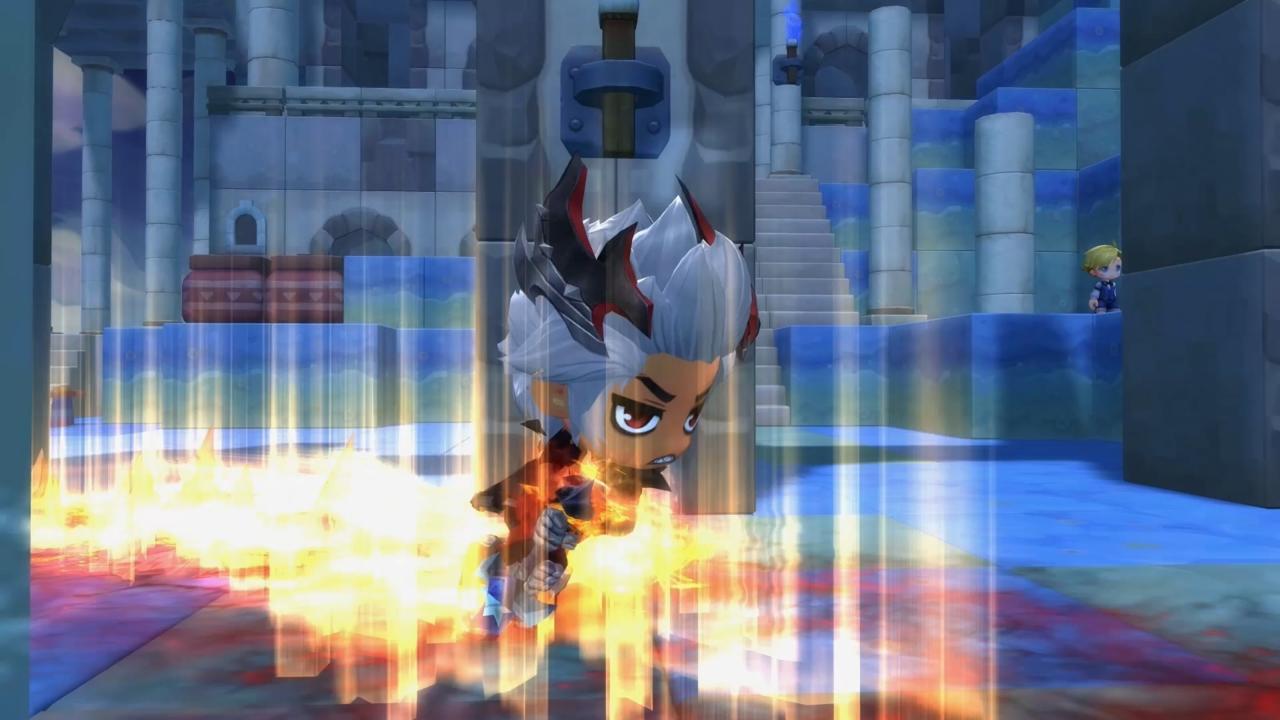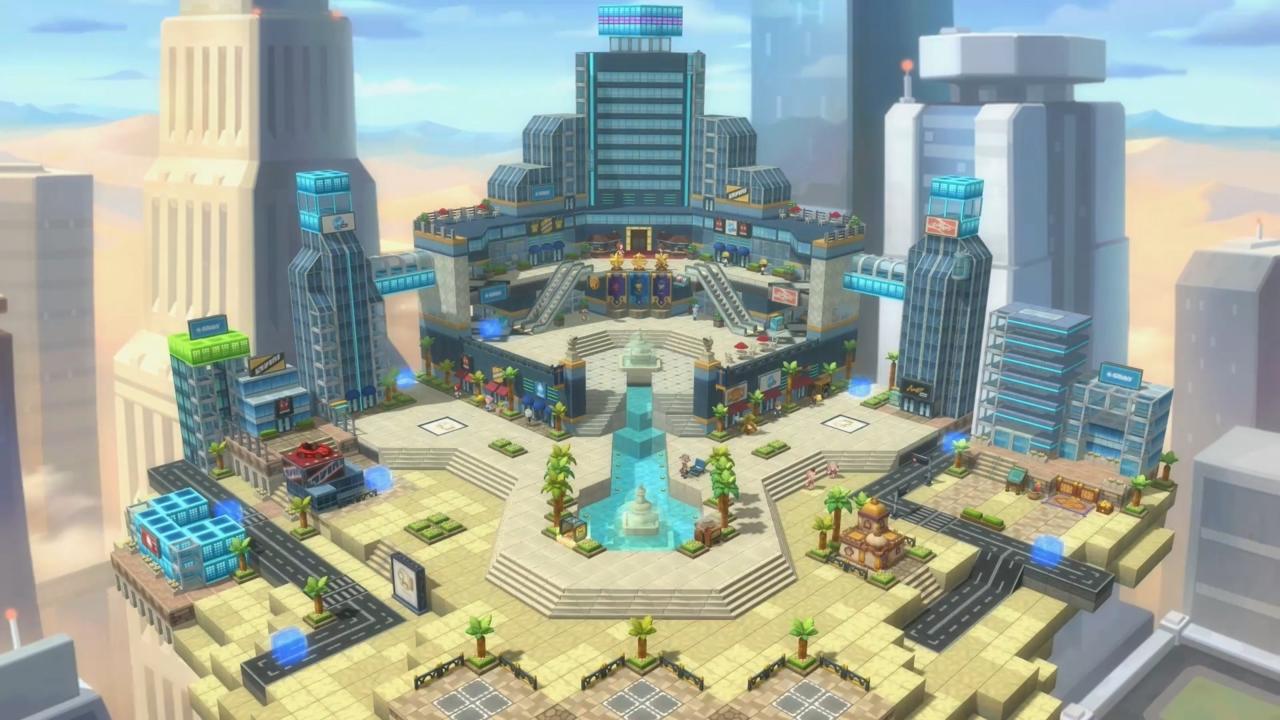Editor's Note: It was brought to our attention after posting this interview that the store for user-generated content in MapleStory 2 includes inappropriate and offensive content. We have reached out to Nexon for clarification of its plans to address these concerns. Nexon responded with its general statement on the state of the game's user content:
"All the items under the "Design Shop" are created by players, not Nexon. Our policy is to let players create, but we review and ban players and content based on ToS and reports of offensive content.
"We actively monitor the Design Shop for offensive material as well as have a reporting system so that players can report content they find offensive through built-in tools. Based on the report, we tightly review every single item and remove the item from the shop, and from the inventory of the players who purchased, and ban player accounts. Content containing sexual, racist, hateful or other inappropriate items are flagged higher in priority for removal. Players who post offensive items or images are subject to being banned permanently from the game. We have been acting very quickly and ask that whenever players see those items in the shop to report immediately using the report button.
"Given the volume of the reports, there has been a delay in the review process. We are trying our best to continue to reduce the gap and speed up the response time to make a better game and maintain a respectful community."
The original story follows below.
MapleStory was one of those games you sunk hours into because you had the time to burn and didn't really have the cash to spend on retail games or monthly fees for persistent MMORPGs. It was an early example of the modern free-to-play model back when subscriptions were the norm. The game was simple in scope; MapleStory works as a 2D side-scrolling RPG with multiple classes, and quests for fighting increasingly powerful (and sometimes cute) enemies. And a simple chibi art style and catchy soundtrack pulled it all together.
It's been 15 years since Maplestory first launched in Korea, and the sequel has officially launched in the West with the localized version of MapleStory 2--the game has been live in Korea since 2015. In that time, Nexon has adapted its long-time MMORPG franchise with an overhauled economy and 3D gameplay. We were able to speak with Nexon America president Jungsoo Lee and live games department director Hyun Joo Kim about the transition and what it's like to bring the sequel westward. The following interview was edited for clarity and readability.
Did you approach MapleStory 2 with the original audience in mind, or was the approach to go for a completely different audience this time around?
Jungsoo Lee: I wouldn't say we have a specific target audience for MapleStory 2. Of course, we are going to reach out to all the old MapleStory fans, but because [the] game has been significantly grown from all this different content, a lot of players actually left. They feel like it's a different MapleStory. Our approach has been 'let's test the market' to see what kind of players really like the game.
Hyun Joo Kim: I think also MapleStory 2 offers a wide variety of content. You can do practically anything in this game, if you're into housing, customization, etc. MapleStory [original] obviously had it, but we now offer more content. You can now make your own costumes, create your own dungeons, which we also showcase with community events. So, I think any type of player, even if you're not particularly interested in Maple world, the game may have a lot of fun and we saw that through [the] beta.

There are so many free-to-play games out there now, and the genre has evolved drastically since the original MapleStory. What kind of modernizations have you incorporated into MapleStory 2?
Lee: Well, it's 3D, some UGC [user-generated content] features, so we haven't meant to make a game sandbox, but we do have similar kind of content incorporated into the game. So, Design Lab, which we announced during our MapleStory Premiere Event, there will be something similar to Roblox. So, we are trying to help content creators craft their own MapleStory experience using all the game assets. That's a small part of it, and housing is something similar to, I'd say Minecraft, if you like building stuff.
We have a bunch of templates and you can create your own vanity clothing, even the car mounts so you can create your own car designs. Also, we have instruments, twenty-plus different types of instruments in the game, that you can use to generate your own music. You can actually play as a band. There's a concert hall where you can play with your friends. They do their own competitions. So, those are all kinds of social plus more modern trends like Roblox, like Minecraft, all those games. Those are kind of incorporated in a MapleStory way.
Can you speak to the philosophy behind the microtransaction model?
Lee: We do understand that MapleStory has a kind of notorious reputation of like pay-to-win. At the time we weren't concerned about that. Good thing is developers for MapleStory 2 are well aware that it should never end being pay-to-win. So, we worked with our development team and the main items for sale in the game are really similar to our very first version of MapleStory. I was a producer working on MapleStory around 2005-06. There was a philosophy we had internally as a team that we weren't going to sell extra XP coupons, and at the time our best sellers were pets, hair coupons, so our model is really similar to that.
A few things that we are adding on top of that is because of our designer's shop. First, players can buy templates for like two or three dollars. They can design their own stuff, and actually sell it in our cash shop. So, one difference will be our content creators in the game will be able to make our currency [Blue Merets] by creating clothing and selling them. And we get a small cut of the revenue.
Is that done through in-game currency?
Lee: Yes, it's through in-game currency.
We've actually taken feedback from the players, like 'we are concerned this can be pay-to-win' so we have removed pretty much everything [pay-to-win]. So, now we're in a place where we're really thinking through and making sure we are have enough of a revenue stream to sustain the service in case, you know, we don't make enough. But looking at the looks of the game, we are very confident. Like, the characters are super cute, people are really into customization right now. So we're confident we can actually keep our current model and sustain the service.
More games are moving towards a sort of live service model, constantly feeding content for the game. Will that be the case for MapleStory 2?
Lee: We do have pretty much all of our roadmap planned out to Q1 2019 for now. It will definitely be similar to MapleStory when I was working on the game where we're planning six, seven months ahead. If not, we couldn't get any localized stuff or optimizations through our service. We're doing that for MapleStory 2.
In original MapleStory, some people felt that progression was slow, so they would go on private servers to speed things up. How do you feel about the progression system and the tweaks you've made this time around?
Lee: In general, the level progression is really fast. Really fast. So, basically getting to level fifty will take maybe a week. But the difference there is MapleStory 2 has a great epic questline you follow. Once you complete all the epic quests in the story, you actually reach max level.
But the thing is we have multiple classes, and the main story is shared among all the classes. So, players who actually worked on their first one [character], we don't want them to go through another same story for all the other classes. We are creating various ways to level up. So you can just, grind, or go fishing, etc. XP is dispersed into all of these, whatever you want to do.

Can you speak to the localization process? When you think about localization, you tend to think about dialog sequences in RPGs and getting phrases across and interpretations of certain idioms in different languages. But specifically for MapleStory, what are the unique challenges? Is it heavy on dialogue, or is it mainly in menu/interface design?
Kim: Well, because MapleStory is an MMORPG, it has a lot of text. And because we're translating it into so many languages, for example certain languages like German are very long, trying to fit that into the existing UI is very difficult. And we also have a lot of VO [voiceovers] in the game, so having all of the files ready in time, lining up the actors and the studio time, it's all very planning-heavy. We definitely have to work with the devs on getting game assets, voice files, and all of that. And this has been a very good collaboration because they were able to fix a lot of that, and the number of text paths we have is already about half of what's in MapleStory, which, again has been in service for thirteen years.
Lee: I started my career at Nexon, but for a few years I went to work for other companies, and in general we [Nexon] invest a lot in localization. We have a really strong team, and their process is really copy editing-heavy. What we've seen from some of the games that we've serviced in the past was basically, outsource and localize and just put it in the game. Sometimes the translation is kind of messy, although we expend tons of money to translate everything. We do have a big copy editing team that plays the game to make sure the story feels right.
What's one thing you want to add about bringing MapleStory 2 to the west?
Lee: We've been trying a really different approach. I mean, it's entirely different, because when we first started seeing MapleStory back in 2005-06, our team was very small, very transparent, and we tried to do whatever we could to satisfy our players. At a certain point over the years, we focused on expansion. And it was sad to kind of see MapleStory losing more of its player base gradually up to last year. But now, we're finally going back to our roots. And starting this year, we are actually seeing the growth in the audience for MapleStory [original] and 2. We have been stepping up our game and trying to be more transparent and engage more players, with our developers, our publishing team.
So, what I definitely want to highlight is our strategy going forward will be different compared to the last few years: to stick to our roots, focus more on player communication and stability. It will all be a part of MapleStory 2. That's why we're actively communicating, we are avoiding pay-to-win, because if you don't say that out loud, there will be tons of players who remember MapleStory and will say Nexon equals pay-to-win.
Kim: I think I'm just very excited for MapleStory to grow. I joined the company and came because I love the game and it's been so great to see the brand and community especially.












